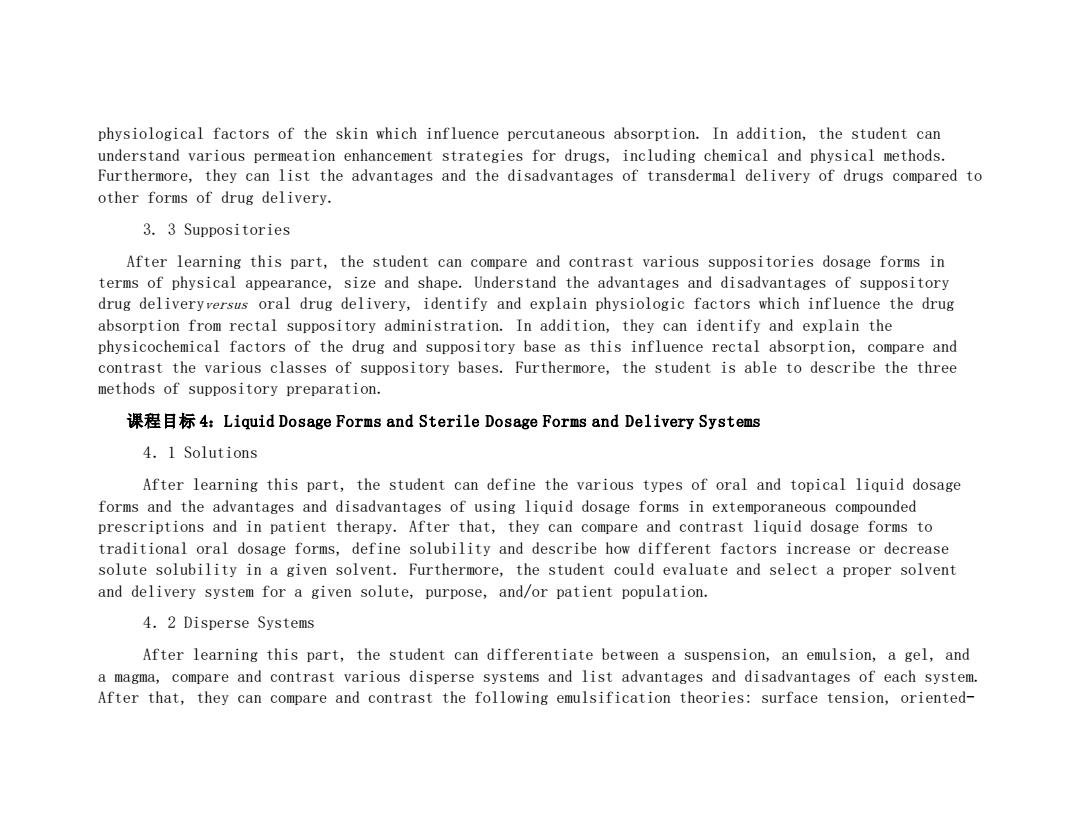正在加载图片...

physiological factors of the skin which influence percutaneous absorption.In addition,the student can understand various permeation enhancement strategies for drugs,including chemical and physical methods. Furthermore,they can list the advantages and the disadvantages of transdermal delivery of drugs compared to other forms of drug delivery. 3.3 Suppositories After learning this part,the student can compare and contrast various suppositories dosage forms in terms of physical appearance,size and shape.Understand the advantages and disadvantages of suppository drug deliveryversus oral drug delivery,identify and explain physiologic factors which influence the drug absorption from rectal suppository administration.In addition,they can identify and explain the physicochemical factors of the drug and suppository base as this influence rectal absorption,compare and contrast the various classes of suppository bases.Furthermore,the student is able to describe the three methods of suppository preparation. 课程目标4:Liquid Dosage Forms and Sterile Dosage Forms and Delivery Systems 4.1 Solutions After learning this part,the student can define the various types of oral and topical liquid dosage forms and the advantages and disadvantages of using liquid dosage forms in extemporaneous compounded prescriptions and in patient therapy.After that,they can compare and contrast liquid dosage forms to traditional oral dosage forms,define solubility and describe how different factors increase or decrease solute solubility in a given solvent.Furthermore,the student could evaluate and select a proper solvent and delivery system for a given solute,purpose,and/or patient population. 4.2 Disperse Systems After learning this part,the student can differentiate between a suspension,an emulsion,a gel,and a magma,compare and contrast various disperse systems and list advantages and disadvantages of each system. After that,they can compare and contrast the following emulsification theories:surface tension,oriented-physiological factors of the skin which influence percutaneous absorption. In addition, the student can understand various permeation enhancement strategies for drugs, including chemical and physical methods. Furthermore, they can list the advantages and the disadvantages of transdermal delivery of drugs compared to other forms of drug delivery. 3. 3 Suppositories After learning this part, the student can compare and contrast various suppositories dosage forms in terms of physical appearance, size and shape. Understand the advantages and disadvantages of suppository drug deliveryversus oral drug delivery, identify and explain physiologic factors which influence the drug absorption from rectal suppository administration. In addition, they can identify and explain the physicochemical factors of the drug and suppository base as this influence rectal absorption, compare and contrast the various classes of suppository bases. Furthermore, the student is able to describe the three methods of suppository preparation. 课程目标 4:Liquid Dosage Forms and Sterile Dosage Forms and Delivery Systems 4.1 Solutions After learning this part, the student can define the various types of oral and topical liquid dosage forms and the advantages and disadvantages of using liquid dosage forms in extemporaneous compounded prescriptions and in patient therapy. After that, they can compare and contrast liquid dosage forms to traditional oral dosage forms, define solubility and describe how different factors increase or decrease solute solubility in a given solvent. Furthermore, the student could evaluate and select a proper solvent and delivery system for a given solute, purpose, and/or patient population. 4.2 Disperse Systems After learning this part, the student can differentiate between a suspension, an emulsion, a gel, and a magma, compare and contrast various disperse systems and list advantages and disadvantages of each system. After that, they can compare and contrast the following emulsification theories: surface tension, oriented-